#Jingdezhen ware
Text


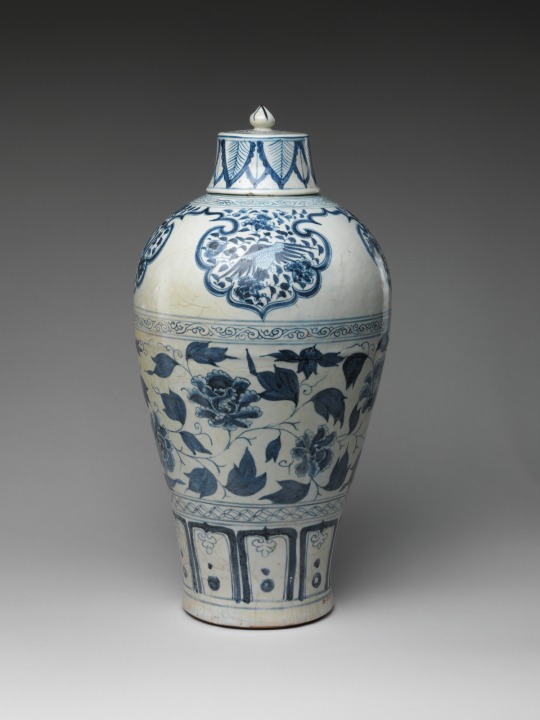

Bottle with Peony Scroll, mid-14th century
Yuan dynasty (1271–1368), China
Porcelain painted with cobalt blue under a transparent glaze (Jingdezhen ware)
H. 17 1/2 in. (44.5 cm)
The structured surface of this bottle ultimately derives from the Islamic cultures of West Asia. The designs painted on the surface of the bottle also illustrate the complicated ties between China and other regions in the fourteenth century: the patterns on the neck parallel the cloud-collar designs often found in textiles and clothing in China and the Islamic world; the scrolling peonies that decorate the center of the bottle derive from longstanding Chinese traditions; and the stylized lotus petals on the base allude to imagery found in Indo-Himalayan art.
Collection of the Metropolitan Museum of Art
#Chinese#Yuan dynasty#art#art history#ceramic#porcelain#Jingdezhen ware#monochrome#blue#cultural amalgam#pattern#design#textile art#flowers#peony#lotus#leaves#14th century#The Met#metropolitan museum of art
23 notes
·
View notes
Text
#FrogFriday:
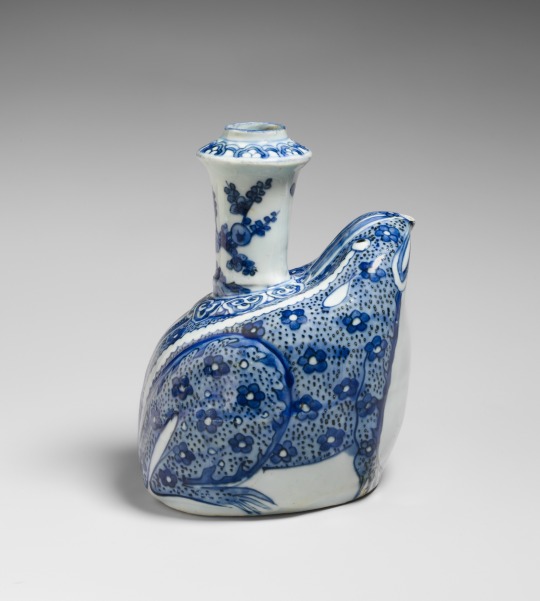

Frog-Shaped Pouring Vessel (Kendi)
China, Ming dynasty, Wanli period (1573–1620), late 16th–early 17th c.
Porcelain painted w/ cobalt blue under transparent glaze (Jingdezhen ware)
Dimensions: H. 7 1/4 in. (18.4 cm); W. 4 1/2 in. (11.4 cm); D. 5 3/8 in. (13.7 cm)
The Metropolitan Museum of Art, New York 2009.107
#animals in art#Chinese art#Asian art#East Asian art#kendi#ceramics#porcelain#Jingdezhen ware#decorative arts#16th century art#17th century art#Metropolitan Museum of Art New York#Frog Friday
22 notes
·
View notes
Text
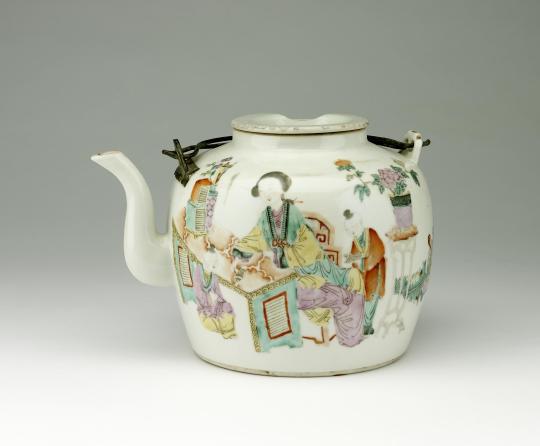
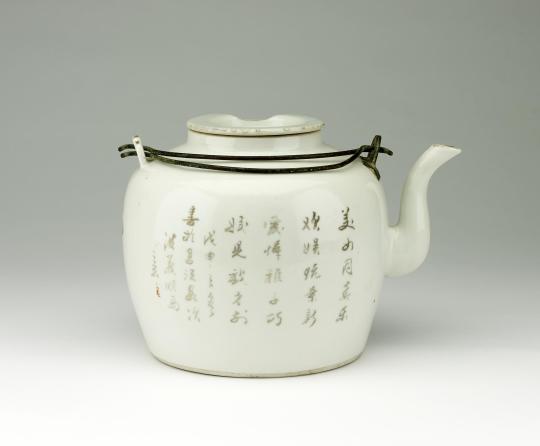
hong yishun 洪義順 (painter), round porcelain teapot with spout and two attachments (one replaced with metal ring) for wire handle. painting in colored enamels shows a woman seated at a table, reading, with two children; the reverse side has a verse, date, and painter's name. made in jingdezhen. late qing dynasty, 1848 or 1908.
the inscription reads 美女同春樂,歡娛玩景新,愛憐稚子巧,姣兒戲身旁。戊申之冬月,書于昌江客次,洪義順寫意。"enjoying spring with a beautiful woman, and she delights herself in the newly-grown world. she showers love on the children; the dear things play close by her side. // winter of year 48 [of the sexagenary cycle], written as a visitor to changjiang district [of jingdezhen city]. painted by hong yishun."
a mark on the bottom reads "made during the tongzhi period", which does not match with the sexagenary cycle date given above; perhaps it is a new (1908) painting on an old (1862-1874) piece.
#china#qing dynasty#late qing dynasty#jingdezhen ware#decorative arts#museum trawling#image source: british museum#do not @ me abt the translation of that verse i am tired and stupid. thankyou.
11 notes
·
View notes
Photo
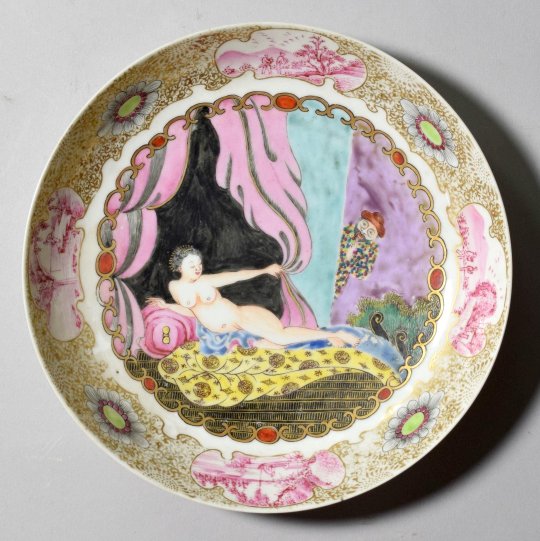
Porcelain dish decorated in overglaze enamels and gilding with a 'gallant' scene, China, Qing dynasty, ca. 1750
“This dish, produced in Jingdezhen in southern China and decorated in Canton, belongs to a group of Chinese export wares characterised by erotic or 'gallant' subjects. The particular scene on this example shows a reclining naked woman being viewed by a voyeur or 'peeping Tom' dressed as Harlequin. Erotic subjects were part of the Chinese tradition, but this theme can only be found on porcelain exported to Europe.”
(via V&A)
40 notes
·
View notes
Text

transcript under cut:
November 02
Lianna Schreiber
In the dream Earth is blue / Cool and round as Jingdezhen ware / Or the glaze
Of my brother’s eye cooling / The lid lifted partway / The cup filling blue / Peach / Quince
or plum bloom / Misty / Flushed / As though Death
Has caught him between dreaming cycles / His pale mouth / For once red as a girl’s
She is only a speck / Sweet Zhuchka / Clueless / Brother-clueless / Staring at the vitreous alien field
Thinking
Of the sour green reek of the streets / With a howl
Moscow in winter / French country sprawling as the seas rise
Was he hungry / Was she thinking of steaming bone broth
It is my dream so you’d think I would know
You’d think the sustainer would detach / That his body wouldn’t be dragged out and folded behind the wheel
Little white house with its green windows / White Moscow with its sour green smell
Instead sunrise / January sunrise
Her lolling tongue red / His drifting eye blue
My hands white and shaking / Stained green
O God / Do the dead eat when we give away our bowls / Can the living heart be serene
31 notes
·
View notes
Text

“Langyao-red glazed Zun (vase) Jingdezhen Ware Kangxi Reign (A.D.1662-1722) Qing H.11.5cm Mouth D.10.4cm Foot D.5.4cm”
From: “Shanghai bo wu guan Zhongguo gu dai tao ci guan = Ancient Chinese Ceramic Gallery, the Shanghai Museum” by Shanghai bo wu guan; 1995.
86 notes
·
View notes
Text
China roja. Porcelana, cerámica ...

GRAN JARRÓN DE BOTELLA ESMALTADA Y DORADA DINASTÍA QING, SIGLO XVIII
CerámicaSílice (arena, cuarzo...)Alúmina (caolín, arcilla)Óxido de hierroPotasa (fondant)Otros elementosCerámica roja Shang59.3 %16.2 %6.3 %2.7 %15.5 %Cerámica gris Shang66.4 %19.3 %5,8 %2.5 %6.0 %Proto-celadon Zhou (Xi'an)72.4 %19.3 %1.6 %3.8 %2.9 %Celadón Song76.2 %17.6 %0.6 %2.8 %2.8 %Porcelana Ming73.6 %20.1 %0.9 %2.9 %2.5 %Tarro cubierto con diseño de hoja marrón sobre fondo blanco. Jizhou Ware. Song del sur - Yuan, A.D. 1127-1368.Zun en forma de granada tipo ge. Jingdezhen Ware. Reinado Yongzheng (A.D. 1723-1735), Qing.
Esta tabla permite sacar algunas conclusiones. :
la verdadera ruptura es entre las cerámicas Shang (entre los 1767 y 1122 antes de la era común, fechas tradicionales) y los proto-celadones Zhou (entre los 1046 y 256 aC), mucho más que entre estos mismos proto-celadones Zhou y la porcelana Ming (desde 1368 hasta 1644 después de la era común);
Esta ruptura se caracteriza ante todo por la disminución de las impurezas: óxido de hierro, cuya eliminación produce una pasta blanca, y los otros elementos, que incluyen en particular manganeso, magnesia, cal (que también es un fundente) y varios desechos;
El otro elemento importante es el aumento en el contenido de sílice cuando se trata de celadón y porcelana. El nivel de alúmina, en el caolín, por ejemplo, está aumentando, pero es bajo. Finalmente, la tasa de potasa (el fudente) es estable.
Los chinos consideran que algunos protoceladones son en realidad porcelanas: de hecho, es muy temprano, desde la dinastía Han del este, alrededor de los siglos i y ii cuando aparecieron las cerámicas consideradas hoy por la mayoría de los expertos como las primeras porcelanas verdaderas.
3 notes
·
View notes
Photo

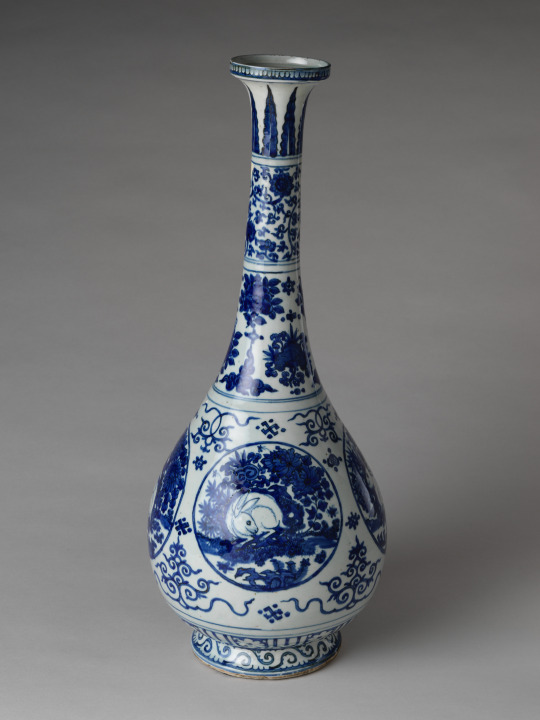

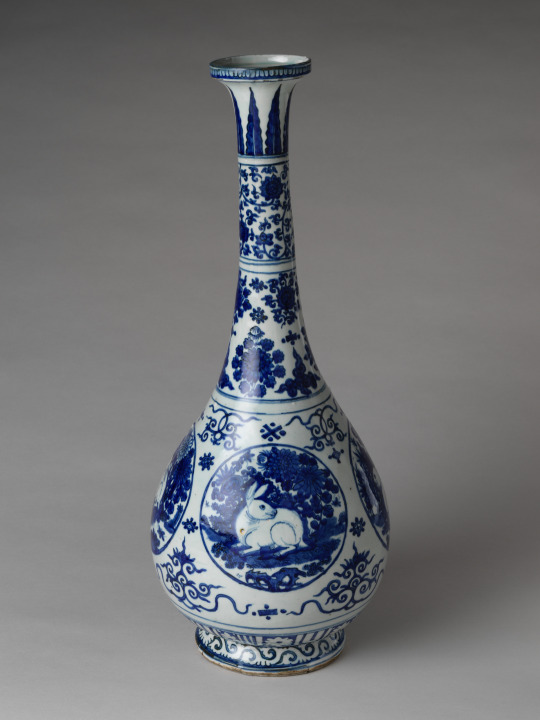

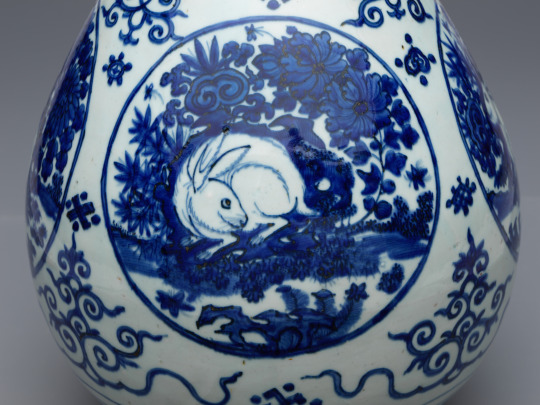
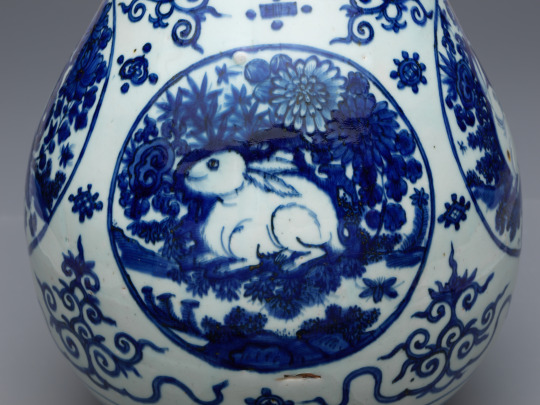
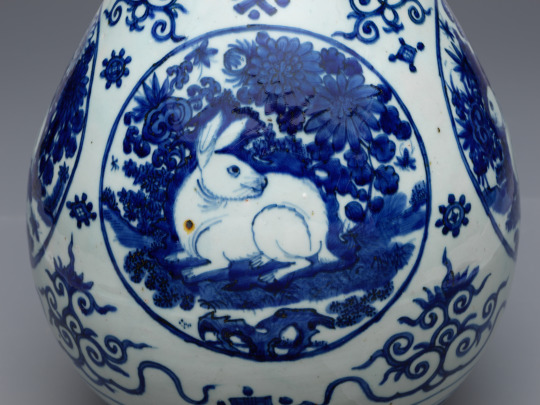
Vase with rabbits, China, Ming dynasty (1368–1644), Late 16th century,
High-fired porcelain decorated with intense blue pigment under a clear glaze reached an unprecedented height of technical excellence and artistic sophistication during the Ming dynasty, when fine porcelain wares were mass produced and sold to many parts of the world.
Their decoration attests to the active cultural exchanges facilitated by maritime trade. The animated rabbits are derived from Chinese sources, whereas the arabesques of scrolling vines and flowers are common motifs in Islamic art.
Porcelain painted in underglaze cobalt blue (Jingdezhen ware)
Courtesy:Met Museum
#art#design#vase#cobalt#blue#china#ming dynasty#16th century#year of the rabbit#happy lunar new year#style#history#met museum#happy chinese new year
27 notes
·
View notes
Text


A Magnificent Langyao Baluster Vase, Guanyin Zun, Kangxi Period (1662-1722), 44.5 cm high, gilt metal stand.
Note: The term langyao (lang ware), derives its name from Lang Tingji, director of the official kilns at Jingdezhen between 1705-1712, who is credited with the revival of monochrome glazes and particularly copper-red glazes. The copper-red color is often considered the most challenging to regulate during the firing process as exactly the right conditions are required within the kiln to achieve the rich tones demonstrated by the present lot. Although copper-red was used successfully in the Ming dynasty, particularly in the Xuande period, the copper-red monochrome glazes seen in the Qing dynasty became even more refined and were of an exceptionally even and vibrant tone. The fine glaze and elegant form of the present vase exemplifies the skill of the Chinese potters under Lang Tingji.
Courtesy Alain Truong
5 notes
·
View notes
Photo
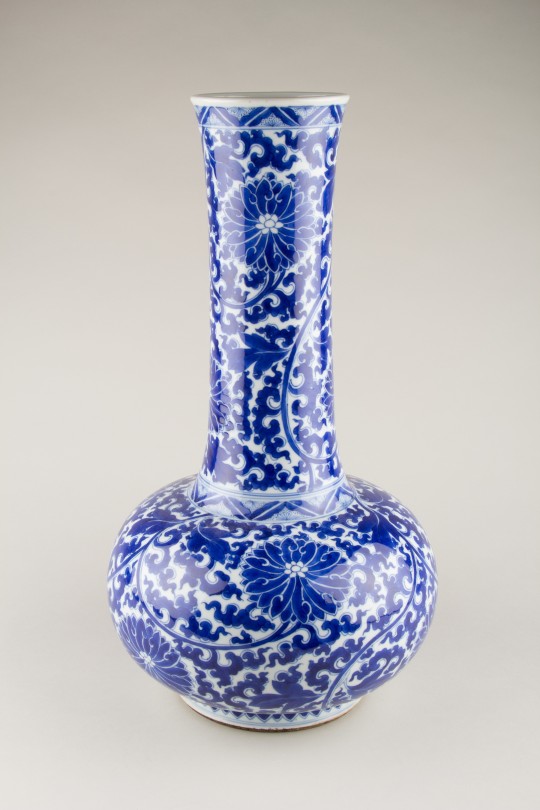
Bottle vase with floral scrolls
Late 17th–early 18th century, China
Porcelain painted in underglaze cobalt blue (Jingdezhen ware)
8 notes
·
View notes
Text

Headrest in the Form of a Theater, late 13th–mid-14th century; Chinese, Yuan dynasty; Jingdezhen ware; porcelain with carved and applied decoration under bluish-white (qingbai) glaze; 6 3/4 x 12 x 6 3/4 inches; Saint Louis Art Museum. This is a rare porcelain headrest in the form of a theater with a surrounding balustrade. The object is modeled in high relief on all four sides with figural and architectural details. The shaped top is slanted toward one of the long sides and decorated with a design of interlocking coins within an undulating border. During the Yuan dynasty, drama attained such a high point in the history of Chinese literature and performing arts that theatrical structures inspired the production of ceramic headrests
4 notes
·
View notes
Photo

Wine Cup with Stand, 13th century
Song dynasty, China
Qingbai ware porcelain with pale blue glaze
2 5/8 x 2 9/16 in. (6.67 x 6.51 cm) (a: cup), 3 1/2 x 5 7/8 in. (8.89 x 14.92 cm) (b: stand)
The Song dynasty (960-1279) saw a tremendous increase in the production of fine, white stoneware and porcelain began to be made in kilns throughout north and south China. The most important group of southern white ware came from the Jingdezhen kilns in Jiangxi province. Known as qingbai (bluish-white), it had a fine, white paste and was wood-fired in a reducing atmosphere. Totally lacking decoration, this thin-walled wine cup and accompanying saucer-stand rely entirely on purity of form and color for their aesthetic impact. Although the best qingbai ceramics were light, elegant, and thin-walled with translucent gemlike, blue-tinted glaze, the ware was not greatly appreciated by the Chinese court.
Collection of the Minneapolis Institute of Art
#Minneapolis Institute of Art#art#art history#Song dynasty#Chinese#ceramic#porcelain#qingbai ware#Jiangxi#Jingdezhen ware#minimalism#13th century#stoneware#celadon
9 notes
·
View notes
Text
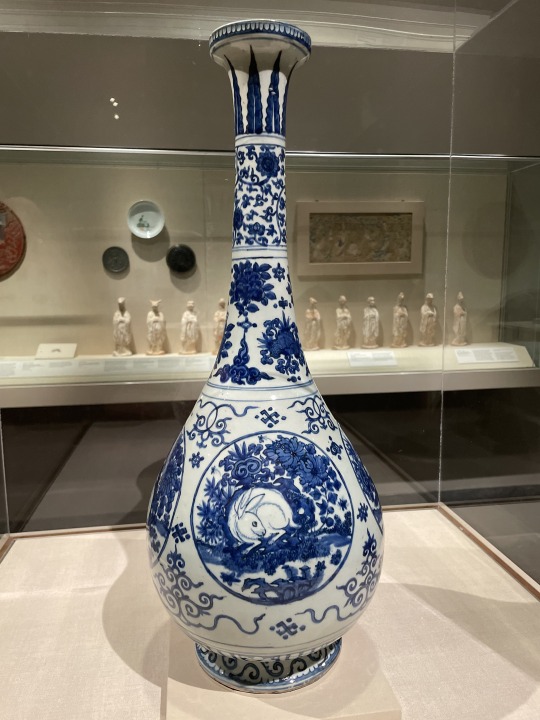


#LunarNewYear #YearOfTheRabbit at the The Metropolitan Museum of Art, New York:
Vase with rabbits
Ming dynasty (1368-1644), late 16th century
porcelain painted in underglaze cobalt blue (Jingdezhen ware)
H. 23 in. (58.4 cm)
"High-fired porcelain decorated with intense blue pigment under a clear glaze reached an unprecedented height of technical excellence and artistic sophistication during the Ming dynasty, when fine porcelain wares were mass produced and sold to many parts of the world. Their decoration attests to the active cultural exchanges facilitated by maritime trade. The animated rabbits are derived from Chinese sources, whereas the arabesques of scrolling vines and flowers are common motifs in Islamic art."
(Islamic decorative motifs & Arabic/Persian inscriptions also became common under the Zhengde Emperor due to the influence of the many Muslims serving in his court.)
Photographed on display at the Met's Celebrating the Year of the Rabbit exhibition; catalog entry here.
#rabbit#rabbits#mammals#China#Chinese art#Asian art#vase#ceramics#porcelain#blue and white porcelain#Jingdezden ware#16th century#Zhengde emperor#Ming dynasty#Metropolitan Museum of Art#Celebrating the Year of the Rabbit#exhibition#museum visit#Lunar New Year#Year of the Rabbit#animals in art
4 notes
·
View notes
Text
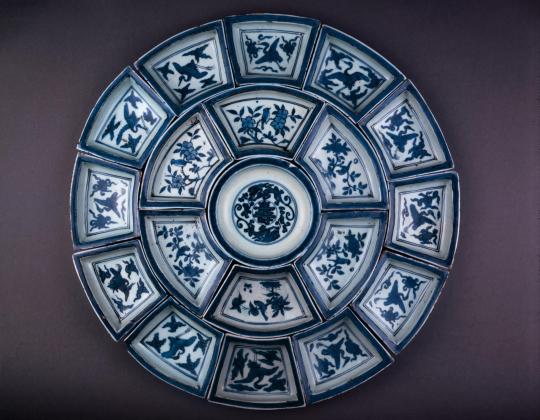
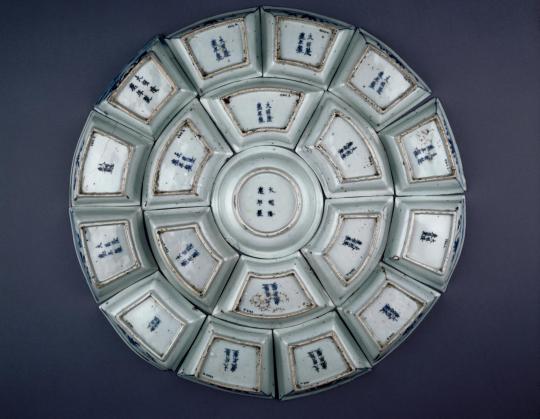
set of 18 blue-and-white porcelain dishes in two concentric circles around a center. the outer circle of dishes shows cranes among clouds; the inner, songbirds on flowering branches. the center dish depicts two dragons circling the character "壽" (longevity). the bottom of each dish is marked with the reign period of production. made in jingdezhen. ming dynasty, longqing period, 1567-1572.
#china#ming dynasty#longqing period#jingdezhen ware#qinghua#decorative arts#museum trawling#image source: british museum#sorry to say it but i love the british museum they have real object descriptions. IN CHINESE so i can check things.
5 notes
·
View notes
Text
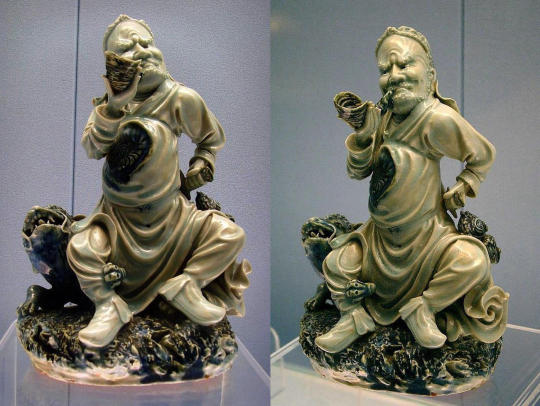
MWW Artwork of the Day (8/12/23)
Ming Dynasty, Wanli Reign (China, 1572-1620)
Man, blowing a conch, seated on an animal (c. 1600)
Jingdezhen ware, underglaze blue ceramic statue
The Shanghai Museum
The Ming Dynasty saw an extraordinary period of innovation in ceramic manufacture. During the Xuande reign (1425–35), a technical refinement was introduced in the preparation of the cobalt used for underglaze blue decoration. Prior to this the cobalt had been brilliant in color, but with a tendency to bleed in firing; by adding a manganese the color was duller, but the line crisper. Xuande porcelain is now considered among the finest of all Ming output. Enameled decoration was perfected under the Chenghua Emperor (1464-1487), and greatly prized by later collectors. Indeed by the late sixteenth century, Chenghua and Xuande era works (especially wine cups) had grown so much in popularity, that their prices nearly matched genuine antique wares of Song or even older.
1 note
·
View note
Text
The most unlikeable porcelain ever made!
When the firing of porcelain with ease, there was a desire to use ceramics to express another kind of content. From early imitations of creatures, such as the feathers of birds and the texture of natural stone, to the Qing dynasty when it evolved into an omnipotent imitation of life, with animals, flowers and birds, vegetables and fruits.

This imitation of the appearance of objects or their material porcelain products, known as bionic porcelain, is the name from the Qing dynasty Zhu Yan "Tao said".
Bionic porcelain is one of the most dazzling wonders of Chinese ceramic art, and all other objects can be imitated. It is astonishing and astonishing in its 'ingenuity'.
The act of imitation has been seen as early as in pottery. In the Qianlong period, the artisans' firing techniques were exquisite and pure, and the control of the kiln's fire and glaze color could be as sophisticated as they wished, with the distinguished potter Tang Ying presiding over the production of all kinds of exquisite wares, producing lifelike imitation porcelain, which could be almost unreal.
Check out our collection of Vintage Teacups, we offer beautifully vintage china for your home.

The reason for its prosperity first and foremost is the support of the emperor himself for the porcelain industry. Huge financial support is a guarantee of the development of the porcelain industry. The Qianlong emperor had a preference for art, porcelain in particular.
From the fourth year of the Qianlong era onwards, "in the Jiujiang Pass funds to use 10,000 taels per year for the production of porcelain, if the income is not enough to cover expenses, you can request an increase in expenditure to the end of the year and then reimbursement".
In the late Qianlong period, "about 7,000 taels of silver were spent each year". According to the archives of the Qing dynasty, the Qianlong emperor also repeatedly ordered Tang Ying, the pottery inspector of Jingdezhen, to imitate famous porcelains of the past.
Secondly, Tang Ying's contribution to porcelain production cannot be ignored. In just a few years during the late Yongzheng period, Tang Ying produced more than forty varieties of imitation porcelain, and a dozen other innovative varieties, with more coming out during the Qianlong period.
Check out our collection of Vintage Teacups, we offer beautifully vintage china for your home.

The Qianlong period can be broadly divided into two types of imitation porcelain: one for the modeling of imitation porcelain; one for the decoration of imitation porcelain. The former imitates the shape of the object, and the latter imitates the pattern of the object's texture. Qianlong period bionic porcelain imitation of many objects, including figures, plants, fruit, and animals. There are also imitations of bronze, lacquer, marbled boxes, wood-grained boxes, woven gold brocade, brocade leather letters, etc., all of which can reach the level of distortion.
All of these imitations of ceramic animals are physically realistic and stunningly detailed. In addition to the morphological imitation, no effort is spared in the imitation of glaze color.
What appears to be a break of clay, a cup of water, some glaze and color, and the work of fire, make the animal's momentary demeanor real. Until you touch it, you may find it hard to believe that it is porcelain. After touching it, you will again marvel at the mastery of its craftsmanship.
The ultimate vintage teacup subscription: https://kimkiln.com/

0 notes